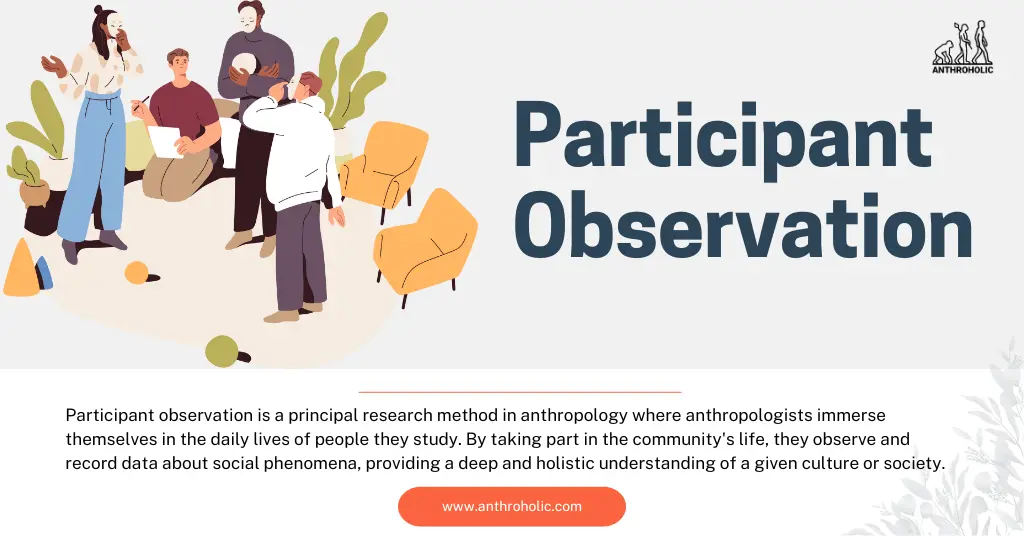AI Answer Evaluation Platform Live Now. Try Free Answer Evaluation Now
Participant Observation
Participant observation is a principal research method in anthropology where anthropologists immerse themselves in the daily lives of people they study. By taking part in the community’s life, they observe and record data about social phenomena, providing a deep and holistic understanding of a given culture or society.

Characteristics of Participant Observation
Participant observation is not merely living or spending time in a particular culture but involves a scientific methodology. Key characteristics include:
- Immersive fieldwork: Anthropologists live within the culture they’re studying for an extended period, often a year or more.
- Participation: They participate in everyday activities, learn the language, and develop relationships with community members.
- Observation: The objective is to observe and record data about a society’s customs, behaviors, and interactions.
- Note-taking: Detailed field notes are critical for later data analysis.
- Reflection and Analysis: Data gathered is analyzed to draw conclusions about the society’s culture.
Benefits and Challenges of Participant Observation
| Benefits | Challenges |
|---|---|
| In-depth understanding of cultural contexts | Time-consuming and demanding |
| Generation of rich, qualitative data | Potential for observer bias |
| Flexibility in research approach | Ethical considerations |
Benefits
- Rich Data: Participant observation allows for the collection of rich, qualitative data. Living within the community fosters deep understanding of customs, norms, and values.
- Contextual Understanding: It provides the cultural context often missed by other research methods.
- Flexibility: As new patterns and behaviors emerge, researchers can adjust their focus.
Challenges
- Time and Commitment: This method requires a significant time commitment, often spanning years.
- Observer Bias: Researchers may inadvertently influence the behaviors of those they are observing.
- Ethical Considerations: Balancing the roles of observer and participant can lead to ethical dilemmas, such as managing informed consent and privacy.
Participant Observation in Practice
Malinowski’s work in the Trobriand Islands is a classic example of participant observation. He lived with the Trobriand Islanders during World War I and studied their culture, practices, and beliefs in detail [1].
Another noteworthy example is Margaret Mead’s study of gender roles in Samoa, where her participant observation revealed that cultural factors significantly influence behavior and societal roles [2].
Data Collection Techniques
- Observation: Observing behaviors, interactions, events, and rituals.
- Interviews: Conducting informal and formal interviews to gain personal insights.
- Surveys: Distributing questionnaires to gather broader data.
- Document Analysis: Reviewing available documents, like historical records, official documents, or personal diaries.
Steps in Participant Observation
- Choosing a Research Site: This involves identifying a culture or community that aligns with the research objectives.
- Gaining Access and Building Rapport: This often involves negotiations with gatekeepers and establishing relationships with community members.
- Data Collection: Implementing data collection techniques and consistently recording detailed field notes.
- Data Analysis and Interpretation: Identifying patterns and themes within the data, interpreting their cultural significance.
- Drawing Conclusions and Reporting: Drawing conclusions based on the data and preparing a detailed report of the findings.
Ethical Considerations in Participant Observation
It is of paramount importance that the anthropologists carry out their research ethically. As participant observation involves being embedded in communities, navigating ethical issues is crucial.
- Informed Consent: Researchers must fully inform participants about the purpose, procedures, risks, and benefits of the research. They should respect the autonomy of participants to decide whether to participate, continue, or withdraw from the study [3].
- Privacy and Confidentiality: Anthropologists must ensure participants’ privacy is protected, and confidentiality is maintained. Personal identifiers should be removed or disguised in the research report [4].
- Respect for Local Customs and Norms: Researchers must respect the cultural practices, traditions, and values of the society they are studying [5].
Validity and Reliability in Participant Observation
Although participant observation generates rich qualitative data, concerns about validity and reliability often arise.
- Validity: This refers to the accuracy and truthfulness of the data collected. To improve validity, anthropologists must take a reflexive approach, constantly questioning their interpretations and perspectives [6].
- Reliability: This refers to the consistency and replicability of the findings. To enhance reliability, anthropologists must keep detailed field notes and use triangulation, where multiple data collection methods are used [7].
The Future of Participant Observation in Anthropology
Despite the challenges, participant observation continues to be a core method in anthropology, offering rich and detailed insights into human societies and cultures. As technology advances, digital ethnography or virtual participant observation are growing areas. This allows researchers to study online communities and cultures, offering new avenues for anthropological inquiry [8].
However, the core principles of immersive fieldwork, participation, observation, and reflection remain foundational to the participant observation method. As we delve deeper into the 21st century, participant observation will continue to be a key tool for anthropologists worldwide.
Conclusion
Participant observation is a critical research method in anthropology. Despite its challenges, it provides a uniquely in-depth, nuanced perspective on the cultures and societies it studies. As anthropology continues to evolve, participant observation remains a cornerstone methodology, proving invaluable in enhancing our understanding of the complexity and diversity of human cultures.
References
[1] Malinowski, B. (1922). Argonauts of the Western Pacific: An Account of Native Enterprise and Adventure in the Archipelagoes of Melanesian New Guinea. Routledge & Kegan Paul.
[2] Mead, M. (1928). Coming of Age in Samoa: A Psychological Study of Primitive Youth for Western Civilisation. William Morrow & Co.
[3] American Anthropological Association. (2012). Principles of Professional Responsibility. AAA.
[4] Confidentiality. In J. J. Lavrakas (Ed.), Encyclopedia of Survey Research Methods (pp. 126-128). SAGE Publications, Inc.
[5] Fluehr-Lobban, C. (2013). Ethics and Anthropology: Ideas and Practice. AltaMira Press.
[6] Flick, U. (2007). Managing Quality in Qualitative Research. SAGE Publications Ltd.
[7] Yin, R. K. (2009). Case Study Research: Design and Methods. SAGE Publications, Inc.
[8] Pink, S., Horst, H., Postill, J., Hjorth, L., Lewis, T., & Tacchi, J. (2016). Digital Ethnography: Principles and Practice. SAGE Publications Ltd.




